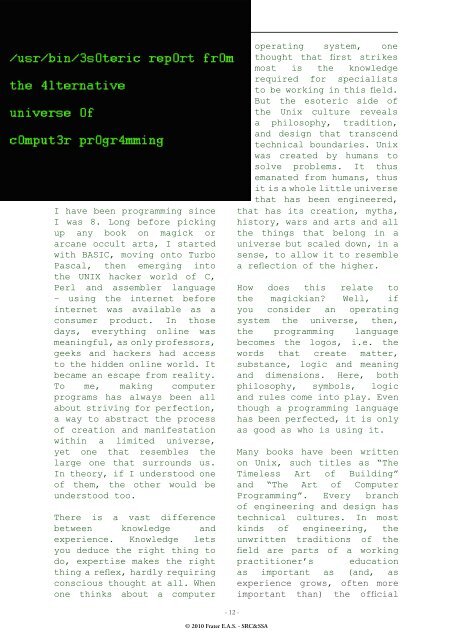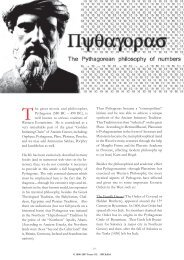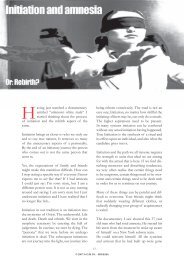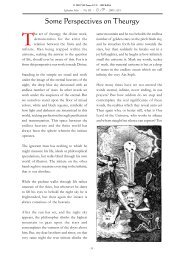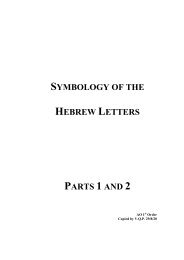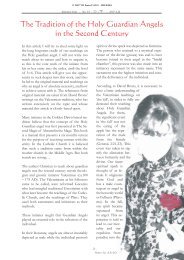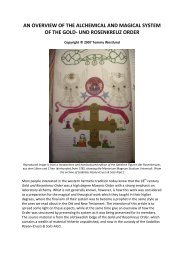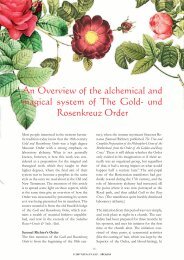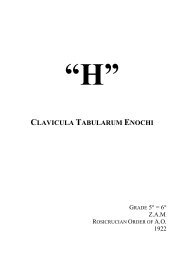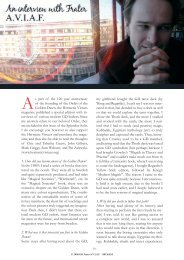2010 AD - Sodalitas Rosae+Crucis & Solis Alati
2010 AD - Sodalitas Rosae+Crucis & Solis Alati
2010 AD - Sodalitas Rosae+Crucis & Solis Alati
Create successful ePaper yourself
Turn your PDF publications into a flip-book with our unique Google optimized e-Paper software.
I have been programming since<br />
I was 8. Long before picking<br />
up any book on magick or<br />
arcane occult arts, I started<br />
with BASIC, moving onto Turbo<br />
Pascal, then emerging into<br />
the UNIX hacker world of C,<br />
Perl and assembler language<br />
– using the internet before<br />
internet was available as a<br />
consumer product. In those<br />
days, everything online was<br />
meaningful, as only professors,<br />
geeks and hackers had access<br />
to the hidden online world. It<br />
became an escape from reality.<br />
To me, making computer<br />
programs has always been all<br />
about striving for perfection,<br />
a way to abstract the process<br />
of creation and manifestation<br />
within a limited universe,<br />
yet one that resembles the<br />
large one that surrounds us.<br />
In theory, if I understood one<br />
of them, the other would be<br />
understood too.<br />
There is a vast difference<br />
between knowledge and<br />
experience. Knowledge lets<br />
you deduce the right thing to<br />
do, expertise makes the right<br />
thing a reflex, hardly requiring<br />
conscious thought at all. When<br />
one thinks about a computer<br />
operating system, one<br />
thought that first strikes<br />
most is the knowledge<br />
required for specialists<br />
to be working in this field.<br />
But the esoteric side of<br />
the Unix culture reveals<br />
a philosophy, tradition,<br />
and design that transcend<br />
technical boundaries. Unix<br />
was created by humans to<br />
solve problems. It thus<br />
emanated from humans, thus<br />
it is a whole little universe<br />
that has been engineered,<br />
that has its creation, myths,<br />
history, wars and arts and all<br />
the things that belong in a<br />
universe but scaled down, in a<br />
sense, to allow it to resemble<br />
a reflection of the higher.<br />
How does this relate to<br />
the magickian? Well, if<br />
you consider an operating<br />
system the universe, then,<br />
the programming language<br />
becomes the logos, i.e. the<br />
words that create matter,<br />
substance, logic and meaning<br />
and dimensions. Here, both<br />
philosophy, symbols, logic<br />
and rules come into play. Even<br />
though a programming language<br />
has been perfected, it is only<br />
as good as who is using it.<br />
Many books have been written<br />
on Unix, such titles as “The<br />
Timeless Art of Building”<br />
and “The Art of Computer<br />
Programming”. Every branch<br />
of engineering and design has<br />
technical cultures. In most<br />
kinds of engineering, the<br />
unwritten traditions of the<br />
field are parts of a working<br />
practitioner’s education<br />
as important as (and, as<br />
experience grows, often more<br />
important than) the official<br />
- 12 -<br />
© <strong>2010</strong> Frater E.A.S. - SRC&SSA
Splendor <strong>Solis</strong> - No. X - ! i d - <strong>2010</strong> A.D.<br />
handbooks and textbooks. Senior<br />
engineers develop huge bodies<br />
of implicit knowledge, which<br />
they pass to their juniors by<br />
(as Zen Buddhists put it) “a<br />
special transmission, outside<br />
the scriptures”.<br />
Genesis: Unix was born in 1969<br />
(UNIX year zero is midnight,<br />
January 1 st , 1970, and time<br />
is measured in the number of<br />
seconds passed since then)<br />
and has been in continuous<br />
production ever since. UNIX<br />
has evolved from big mainframes<br />
onto normal PC and laptop<br />
computers, with the advent of<br />
Linux and Mac OS X. It sort<br />
of represents an anti-culture<br />
from Microsoft Windows.<br />
The Unix philosophy is not<br />
a formal design method. It<br />
is pragmatic and grounded in<br />
experience. It encourages<br />
a sense of proportion and<br />
skepticism – and shows both<br />
by having a sense of (often<br />
subversive) humour.<br />
Looking at the whole, some<br />
rules emanated. Here is a few<br />
examples:<br />
1: Rule of modularity: Write<br />
simple parts connected by clean<br />
interfaces.<br />
2: Rule of Clarity: Clarity is<br />
better than cleverness.<br />
For those of you who like<br />
Gematria, It is interesting<br />
that the rule of Har-Par-Kraat<br />
naturally falls on number<br />
eleven, the number of Magick:<br />
11: Rule of Silence: When a<br />
program has nothing surprising<br />
to say, it should say nothing.<br />
16: Rule of Diversity: Distrust<br />
all claims for the “One True<br />
Way”.<br />
17: Rule of Extensibility:<br />
“Design for the future, because<br />
it will be here sooner than<br />
you think”.<br />
If you are new to Unix,<br />
these principles are worth<br />
some meditation. If you are<br />
a mystic or magickian, these<br />
parables sound familiar. I<br />
find it interesting to see how<br />
once a totally new universe<br />
is manifested from void, a<br />
familiar pattern appears...<br />
One interesting explanation<br />
of the “Rule of Silence”<br />
is explained by the fact<br />
that Unix predates video<br />
displays. On the old printing<br />
terminals of 1969, each line<br />
of unneccessary output was a<br />
serious drain on the user’s<br />
time. That constraint is gone,<br />
but the practice has been kept.<br />
The terseness of Unix programs<br />
has lead to Unix’s success, in<br />
many ways. When your program’s<br />
output becomes another’s input,<br />
it should be easy to pick up<br />
the needed bits. Important<br />
information should not be<br />
mixed in with verbosity about<br />
internal program behaviour.<br />
To achieve enlightenment and<br />
surcease from suffering, Zen<br />
teaches detachment. The Unix<br />
tradition teaches the value of<br />
detachment from the particular,<br />
accidental conditions under<br />
which a design problem was<br />
posed. Abstract. Simplify.<br />
Generalize. Because we write<br />
software to solve problems, we<br />
cannot completely detach from<br />
the problems – but it is well<br />
worth the mental effort to see<br />
how many preconceptions you<br />
can throw away, and whether the<br />
design becomes more compact<br />
- 13 -<br />
© <strong>2010</strong> Frater E.A.S. - SRC&SSA
Splendor <strong>Solis</strong> - No. X - ! i d - <strong>2010</strong> A.D.<br />
and orthogonal as you do<br />
that. Possibilities for code<br />
reuse often result, hence the<br />
popular “Open Source” culture,<br />
why rewrite code and reinvent<br />
the wheel when you can recycle<br />
80-90% of what has been made<br />
before?<br />
Jokes about the relationship<br />
between Unix and Zen are a live<br />
part of the Unix tradition as<br />
well. This is not an accident.<br />
One example is the poem:<br />
“Debugging is twice as hard<br />
as writing the code in the<br />
first place. Therefore, if you<br />
write the code as cleverly<br />
as possible, you are, by<br />
definition, not smart enough to<br />
debug it.” –Brian Kernighan,<br />
co-creator of Unix.<br />
Here is an example:<br />
while ($programming and not<br />
$thinking)<br />
{<br />
$enlightenment++;<br />
}<br />
This program will actually<br />
run on a computer. Translated<br />
into human language, the<br />
program reads thus: “While<br />
the condition of the value<br />
of programming is true and<br />
value of thinking is not true,<br />
the value of enlightenment<br />
increases by the factor of one<br />
for each time continuously in<br />
an infinite loop into eternity”.<br />
Another example where<br />
programming languages can<br />
break out of the box of normal<br />
time-space continuum is the<br />
legendary “camel” code, made<br />
in Perl:<br />
#!/usr/bin/perl -w # camel code use strict;<br />
$_=’ev<br />
al(“seek\040D<br />
ATA,0,<br />
0;”);foreach(1..3)<br />
{;}my<br />
@camel1hump;my$camel;<br />
my$Camel ;while(<br />
){$_=sprintf(“%-6<br />
9s”,$_);my@dromedary<br />
1=split(//);if(defined($<br />
_=)){@camel1hum p=split(//);}while(@dromeda<br />
ry1){my$camel1hump=0 ;my$CAMEL=3;if(defined($_=shif<br />
t(@dromedary1 ))&&/\S/){$camel1hump+=1
Splendor <strong>Solis</strong> - No. X - ! i d - <strong>2010</strong> A.D.<br />
Of course this code actually<br />
runs, too. What does it do?<br />
You guessed it. It prints out<br />
an identical camel.<br />
It reminds me about the last<br />
line of one section of the<br />
loginataka, a discourse between<br />
the student and the hacker on<br />
how to become a hacker, much<br />
resembling a dialogue with a<br />
novise monk and the zen master<br />
where the student is advised<br />
to “travel in the way of the<br />
camel”, meaning of course<br />
the book about the “Perl”<br />
programming language, which<br />
has the image of a camel on<br />
it. (All the O’Reilly books<br />
have pictures of animals on<br />
it, they can be considered the<br />
bibles of Unix culture).<br />
Speak, O Guru: What books should<br />
I study? Are the O’Reilly<br />
“Nutshell” guides a good place<br />
to start?<br />
O, Nobly Born: know that the<br />
Nutshell Guides are but the<br />
outermost Portal of the True<br />
Enlightenment. Worthy are<br />
they (and praise to the Name<br />
of O’Reilly, whose books show<br />
forth the Hacker Spirit in<br />
numerous pleasing ways), but<br />
the Nutshell Guides are only<br />
the Beginning of the Road.<br />
If thou desirest with True<br />
Desire to tread the Path of<br />
Wizardly Wisdom, first learn<br />
the elementary Postures of<br />
Kernighan & Pike’s The Unix<br />
Programming Environment; then,<br />
absorb the mantic puissance of<br />
March Rochkind’s Advanced Unix<br />
Programming and W. Richard<br />
Stevens’s Advanced Programming<br />
In The Unix Environment.<br />
Immerse thyself, then, in<br />
the Pure Light of Maurice J.<br />
Bach’s The Design Of The Unix<br />
Operating System. Neglect not<br />
the Berkelian Way; study also<br />
The Design and Implementation<br />
Of The 4.4BSD Operating System<br />
by Kirk McKusick, Keith<br />
Bostic et. al.<br />
For useful hints, tips, and<br />
tricks, see Unix Power Tools,<br />
Tim O’Reilly, ed. Consider<br />
also the dark Wisdom to be<br />
gained from contemplation of<br />
the dread Portable C And Unix<br />
Systems Programming, e’en<br />
though it hath flowed from the<br />
keyboard of the mad and doomed<br />
Malvernite whom the world of<br />
unknowing Man misnames “J.<br />
E. Lapin”.<br />
These tomes shall instruct<br />
thy Left Brain in the Nature<br />
of the Unix System; to Feed<br />
the other half of thy Head,<br />
O Nobly Born, embrace also<br />
the Lore of its Nurture. Don<br />
Libes’s and Sandy Ressler’s<br />
Life With Unix will set thy<br />
Feet unerringly upon that<br />
Path; take as thy Travelling<br />
Companion the erratic but<br />
illuminating compendium called<br />
The New Hacker’s Dictionary<br />
(Eric S. Raymond, ed., with<br />
Guy L. Steele Jr.).<br />
In this wise shalt thou travel<br />
the Way of the Camel.”<br />
--- From Eric S. Raymonds<br />
“Loginataka”. http://catb.<br />
org/~esr/faqs/loginataka.html<br />
Unix uses Gematria too, in<br />
files, where metadata in the<br />
form of numbers are included.<br />
One way to incorporate such<br />
metadata, often associated<br />
with Unix and its derivatives,<br />
is just to store a “magic<br />
number” inside the file itself.<br />
Originally, this term was used<br />
for a specific set of 2-byte<br />
- 15 -<br />
© <strong>2010</strong> Frater E.A.S. - SRC&SSA
Splendor <strong>Solis</strong> - No. X - ! i d - <strong>2010</strong> A.D.<br />
identifiers at the beginning of<br />
a file, but since any undecoded<br />
binary sequence can be regarded<br />
as a number, any feature of<br />
a file format which uniquely<br />
distinguishes it can be used<br />
for identification. GIF images,<br />
for instance, always begin<br />
with the ASCII representation<br />
of either GIF87a or GIF89a,<br />
depending upon the standard<br />
to which they adhere. Many file<br />
types, most especially plaintext<br />
files, are harder to spot<br />
by this method. HTML files, for<br />
example, might begin with the<br />
string (which is not case<br />
sensitive), or an appropriate<br />
document type definition that<br />
starts with
Splendor <strong>Solis</strong> - No. X - ! i d - <strong>2010</strong> A.D.<br />
the programming code (logos)<br />
the intention of the idea<br />
(will) emerges.<br />
Even the best software tools<br />
tend to be limited by the<br />
imaginations of their designers.<br />
Nobody is smart enough to<br />
optimize for everything, nor<br />
to anticipate all the uses to<br />
which their software might be<br />
put. Designing rigid, closed<br />
software that won’t talk to the<br />
rest of the world is an unhealthy<br />
form of arrogance.<br />
Therefore, the Unix tradition<br />
includes a healthy mistrust<br />
of “one true way” approaches<br />
to software design or<br />
implementation. It embraces<br />
multiple languages, open<br />
extensible systems, and<br />
customization hooks everywhere.<br />
One can say that a potent<br />
manifestation of Gnostic<br />
thought and the polarity of<br />
systems can be best exampled<br />
by Microsoft Windows, the most<br />
prevalent operating system<br />
among personal computers<br />
still, which is a proprietary,<br />
licenced, monopolised closedoff<br />
system where the code is<br />
hidden and you have to be a<br />
hacker to “break out” of the<br />
shell that imprison the user,<br />
contrast this to Linux, an<br />
incarnation of Unix that is<br />
free, open, and where the<br />
user can be instant in control<br />
and see the source code of<br />
any piece of the system. It<br />
puts Adam back in the garden<br />
of Eden, where time began<br />
in year zero (1 st of January<br />
1970), where tapes of free and<br />
open software were circulated<br />
among hackers in Berkeley.<br />
To this day, the utility for<br />
compressing folders in Unix is<br />
simply named “tar”, although<br />
many has forgotten it once was<br />
used mainly on Tape Archives..<br />
by Frater E.A.S<br />
- 17 -<br />
© <strong>2010</strong> Frater E.A.S. - SRC&SSA


